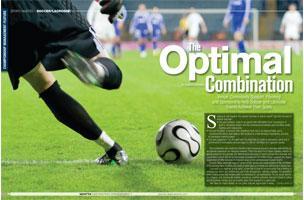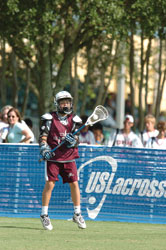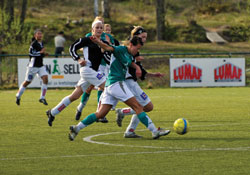
Seeking to put together the perfect lacrosse or soccer event? Use this formula to ensure success:
One part location: close to an airport with affordable fares, housing for at least a thousand people, and fun entertainment venues such as water parks, theatres and restaurants.
One part facilities: a complex with anywhere from six to 20 playing fields, and a championship venue that seats a few hundred to a few thousand spectators, and lots of adjustable meeting space.
One part supporters: on-site staff with the expertise to create a successful event and a community of enthusiasts who are eager to attend, volunteer at or sponsor events.
This combination will create the chemistry that ensures a soccer or lacrosse event will be an exceptional experience for everyone involved. That's the word from Sarah Oglesby, Director of Special Events for US Lacrosse, the national governing body for men's and women's lacrosse,and James Ward, Senior Director of Commercial Development for United Soccer Leagues, the largest organization of elite-level soccer leagues ranging from professionals to youth teams.
 In some cases, especially league championships, venues are chosen based on the hometown of the winning team. In others, the choice is wide open and venues are selected by a bid process.
In some cases, especially league championships, venues are chosen based on the hometown of the winning team. In others, the choice is wide open and venues are selected by a bid process.
"Lacrosse is a relatively young sport, so we like to look for a community that is willing to embrace our event, get involved and add to the atmosphere," explains Oglesby. "It's wonderful when communities step forward with fun activities for our participants. For our youth events, for instance, one community hosted a barbecue, another provided discount tickets to other sporting events nearby, and yet another gave them passes to a ropes park.
"We have so many details on our plate that we appreciate it when communities take the initiative to help us out – whether that's through organizing activities, providing volunteers, or guiding us to local sponsorship."
Ward concurs. "The facilities are typically better positioned to assist with logistics; for a first-time event, operators don't necessarily know the key people in the market as well as the facility operators," he points out. "I think being able to assist in the area of volunteer acquisition and staffing is important. Also, offering access to equipment or other assets to improve the operations and the scope of the event will set a venue apart."
A sure sign that a venue is a good location, says Ward, is a review of the events that have been held there. "We take a good look at who has been there and, most important, if they came back."
Over the past decade, the facilities for these sports have improved considerably as communities vie to attract events and create their own. Three leading examples of this trend are:
The National Sports Center in Blaine, Minn. This is the largest amateur sports facility in the world with more than 600 acres, attracting in excess of 3.3 million visitors every year. Among the hundreds of events it hosts and plans every year, including the Upper Midwest Lacrosse League Championships, is the Schwan's USA CUP. This is the largest youth soccer tournament in the western hemisphere attracting more than a thousand teams from 22 countries. Its amenities include 46 soccer fields and a conference center. There are even dormitories on site that adjoins a cafeteria; the cafeteria is open for major events and when larger groups are staying on campus. A world-class golf course and an eight-sheet ice arena, as well as an abundance of nearby restaurants and shopping provide plenty of things to do off the field.
Dick's Sporting Goods Park and the Pepsi Center in Denver, Colo. These sites are operated Kroenke Sports Enterprises. Dick's Sporting Goods, located in the Denver suburb of Commerce City, is an outdoor venue featuring 18,000 seats and is home to the Colorado Rapids, a professional soccer league and the Pepsi Center is home to the Colorado Mammoth, a professional lacrosse team. The sites host an array of tournaments ranging from merely two teams to large, national-scale events such as all-star games and national championships for organizations such as the MLS (Major League Soccer) NLL (National Lacrosse League) and the NCAA.
Pizza Hut Park in Frisco, Texas, just outside of Dallas, is an outdoor stadium surrounded by 17 soccer fields and can seat 20,500 for soccer games. It is home to the FC Dallas professional soccer team. They host hundreds of soccer events every year, but only a handful of lacrosse events. They are looking forward to eventually attracting a professional lacrosse team. The site features dedicated staff to help event planners sell tickets, and attain publicity and sponsorships.
All three venues both plan and host events, making their staff expert at all aspects of sports event planning – from logistics to sponsorships to marketing.
Planning Matters
As the Director for the Schwan's USA CUP, Teri Vogt is now in the process of planning the world's third-largest soccer event for both 2008 and 2009.
"We're marketing now for our 2009 games; that's the only way we can attract international teams," she explains.
Whether informing travel agents specializing in sports destination tour packages, setting up booths at international soccer events, advertising in programs and on billboards at events around the world, or meeting face-to-face with coaches, the marketing is nonstop between May and December for the following year's event. Simultaneously, Vogt is charged with ensuring all aspects of the present year's event are orchestrated to perfection.
"The Schwan's USA CUP is a year-round effort by many, many people; it's the largest tourism event in Minnesota,"she points out. Because there are so many pieces, Vogt organizes everything through committees; this includes opening ceremonies and awards, transportation, home-stay, scheduling, scoring, referees.
"It's an extensive list," she notes. "The committee chairs report to me. I'm sort of the professional checker, making sure everyone's on track. Fortunately, my gift is working with volunteers and the USA Cup requires more than 1,000 volunteers who help manage the 25,000 people per day who come to our campus.
"Every event leader has his or her own gift to bring to the table;make the most of what you do best and encourage others to bring their own talents to fill in the rest."
Brian Kitts, Senior Director of Marketing and Public Relations for Kroenke Sports Enterprises, advises putting first things first, whether you're planning a tournament for two teams or 200. "Before you decide to move ahead with any event, make sure you've got commitments from people to participate – otherwise it's like throwing a party where no one shows up," he says. "Be realistic about attendance and costs. Use your gut and common sense - put yourself in the shoes of your audience. Make sure registration and ticket prices aren't higher than what people will pay for.'
Ward, Vogt and Oglesby all advise attending a number of events to make note of what works and what doesn't. "I strongly suggest that if you want to develop a lacrosse event, express your interest to the nearest lacrosse chapter of US Lacrosse (go to www.uslacrosse.org) and attend several of their events," says Oglesby.
Attracting Sponsorship
"Sponsorships make an event viable. Sponsors not only allocate resources in terms of funding and volunteers, they lend credibility and can attract other sponsors, participants and fans," says John Connelly, Director of Development and Sales for the National Sports Center; he is charged with attracting sponsors to the center. It's a year-round, full-time job and it's not easy.
 "When it comes to finding sponsors, you're going to get to hear ‘no' a lot more than ‘yes,'" he admits. "So you have to make sure you're matching up the right product with the right audience. Know the demographic of the people who will be attending your event and match them up with the sponsor who wants to reach them. Of course, be sure that you're promoting the product at your event. If the local Coca-Cola distributor is sponsoring, make sure you're selling Coke products."
"When it comes to finding sponsors, you're going to get to hear ‘no' a lot more than ‘yes,'" he admits. "So you have to make sure you're matching up the right product with the right audience. Know the demographic of the people who will be attending your event and match them up with the sponsor who wants to reach them. Of course, be sure that you're promoting the product at your event. If the local Coca-Cola distributor is sponsoring, make sure you're selling Coke products."
Name sponsors, however, are challenging to come by, admits Barclay Kruse, Media Director for the National Sports Center. "When we moved from attracting one million to three million people a year to our campus, that seemed to be the magic number that caught the interest of bigger sponsors," he points out.
It's no wonder that Kitts recommends finding multiple, smaller sponsors. "Too many people spend too much time finding one big, fat wallet when they can be successful with three or four smaller sponsors," he explains.
Connelly offers these tips for attracting sponsorship dollars:
Have a quality venue. "There's too much competition out there not to find the best location for your event."
Plan ahead – at least six to eight months in advance of the event - and pay attention to the events potential sponsors already support. "I research companies who are already sponsoring professional sporting events; if they're successful, they may be interested in allocating resources to our events. Because we're amateur, we're significantly less expensive and yet can give them exposure to millions of people of the same demographic that their professional sports sponsorship reaches."
Invest in paid staff. "Too often, events rely on volunteers. In the short-term, that can work fine, but in the long-term, to be sustainable, you've got to ramp it up a notch and bring in professionals. This will make an impressive difference in the quality of the event," says Connelly, "especially when things go wrong – when the weather is lousy, or the referees don't show up. The volunteers will sustain themselves better with key paid leadership."
Have a plan for growth. "Be flexible and look to grow in a different way; for instance, the weak dollar has made our event more attractive to international teams. We used to be 70 percent local teams, now it's 50-50 national and international."
"The National Sports Center has been a benefit to our local economy," says Curt Larson, Economic Development Specialist for the City of Blaine. "Thanks to this facility, we're the amateur sports capital of Minnesota and even the nation, and many restaurants and retailers have opened shop in our city because of that."
Attracting Opportunity
Michael Hitchcock, General Manager for Pizza Hut Park, is constantly reaching out to the national and international soccer communities to attract events to his facility.
"We can plan an international soccer event with just four weeks advance notice," he says. "We've created a structure so that we can effectively run a professional soccer team, and yet can bring abundant resources to the table for those who want to use our facilities.For instance, we have a ticket sales staff of 16 employees who will work full-time to ensure your event is pro-actively sold. Our staff takes ownership in every event.
"When planners choose our venue, they get so much more than merely a place to hold an event, they get a professional sales, marketing and public relations staff to support them."
It's no wonder that every year, this facility has attracted 1.5 million visitors, guests, and participants from around the world to the region.
The formula for successful soccer and lacrosse events may seem complex, but with the proper foresight, planning and support, you can create a wonderful competitive athletic opportunity that will come out right every time.

